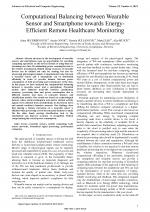| 4/2018 - 1 | View TOC | « Previous Article | Next Article » |
Computational Balancing between Wearable Sensor and Smartphone towards Energy-Efficient Remote Healthcare MonitoringSECERBEGOVIC, A. |
| Extra paper information in |
| Click to see author's profile in |
| Download PDF |
Author keywords
wearable sensors, mobile computing, body sensor networks, biomedical signal processing, performance evaluation
References keywords
mobile(7), computing(6), sensor(5), wearable(4), time(4), systems(4), selection(4), recognition(4), real(4), feature(4)
Blue keywords are present in both the references section and the paper title.
About this article
Date of Publication: 2018-11-30
Volume 18, Issue 4, Year 2018, On page(s): 3 - 10
ISSN: 1582-7445, e-ISSN: 1844-7600
Digital Object Identifier: 10.4316/AECE.2018.04001
Web of Science Accession Number: 000451843400001
SCOPUS ID: 85058816909
Abstract
Recent advances in the development of wearable sensors and smartphones open up opportunities for executing computing operations on the devices instead of using them for streaming raw data. By minimizing power consumption due to the wireless transmission, limited energy resources of wearable devices can be utilized not only for sensing, but also for processing physiological signals. Computational tasks between a wearable sensor and a smartphone can be distributed efficiently in order to provide balance between power consumption of both processing and transmission of the data. In this paper, we have analyzed the computational balancing between a wearable sensor and a smartphone. Presented models show different trade-offs between classification accuracy, processing time and power consumption due to different number and types of extracted features and classification models. Our results are based on a physiological dataset, where electrocardiogram and electro dermal activity signals were collected from 24 individuals in short-term stress and mental workload detection scenario. Our findings show that placing a feature extraction on a wearable sensor is efficient when processing cost of the extracted features is small. On the other hand, moving classification task to the smartphone can improve accuracy of recognition without compromising the overall power consumption. |
| References | | | Cited By |
Web of Science® Times Cited: 6 [View]
View record in Web of Science® [View]
View Related Records® [View]
Updated 2 days, 11 hours ago
SCOPUS® Times Cited: 9
View record in SCOPUS® [Free preview]
View citations in SCOPUS® [Free preview]
[1] Remote Care Assistance in Emergency Department Based on Smart Medical, Zhou, Chengli, Hu, Juan, Chen, Ni, Lv, Zhihan, Journal of Healthcare Engineering, ISSN 2040-2309, Issue , 2021.
Digital Object Identifier: 10.1155/2021/9971960 [CrossRef]
[2] Harmonic Loss Function for Sensor-Based Human Activity Recognition Based on LSTM Recurrent Neural Networks, Hu, Yue, Zhang, Xiao-Qing, Xu, Li, Xian He, Feng, Tian, Zhao, She, Wei, Liu, Wei, IEEE Access, ISSN 2169-3536, Issue , 2020.
Digital Object Identifier: 10.1109/ACCESS.2020.3003162 [CrossRef]
[3] Effective Wavelet Algorithm for an Automatic Detection of Atrial Fibrillation, ARVINTI, B., ISAR, A., COSTACHE, M., Advances in Electrical and Computer Engineering, ISSN 1582-7445, Issue 3, Volume 20, 2020.
Digital Object Identifier: 10.4316/AECE.2020.03006 [CrossRef] [Full text]
[4] A Taxonomy of Low-Power Techniques in Wearable Medical Devices for Healthcare Applications, Tesema, Workineh, Jimma, Worku, Khan, Muhammad Iqbal, Stiens, Johan, da Silva, Bruno, Electronics, ISSN 2079-9292, Issue 15, Volume 13, 2024.
Digital Object Identifier: 10.3390/electronics13153097 [CrossRef]
[5] Intelligent wearable-assisted digital healthcare industry 5.0, Tandel, Vrutti, Kumari, Aparna, Tanwar, Sudeep, Singh, Anupam, Sharma, Ravi, Yamsani, Nagendar, Artificial Intelligence in Medicine, ISSN 0933-3657, Issue , 2024.
Digital Object Identifier: 10.1016/j.artmed.2024.103000 [CrossRef]
[6] An Optimization Approach to Multi-Sensor Operation for Multi-Context Recognition, Kain, Raslan, Hajj, Hazem, Sensors, ISSN 1424-8220, Issue 20, Volume 21, 2021.
Digital Object Identifier: 10.3390/s21206862 [CrossRef]
Disclaimer: All information displayed above was retrieved by using remote connections to respective databases. For the best user experience, we update all data by using background processes, and use caches in order to reduce the load on the servers we retrieve the information from. As we have no control on the availability of the database servers and sometimes the Internet connectivity may be affected, we do not guarantee the information is correct or complete. For the most accurate data, please always consult the database sites directly. Some external links require authentication or an institutional subscription.
Web of Science® is a registered trademark of Clarivate Analytics, Scopus® is a registered trademark of Elsevier B.V., other product names, company names, brand names, trademarks and logos are the property of their respective owners.
Faculty of Electrical Engineering and Computer Science
Stefan cel Mare University of Suceava, Romania
All rights reserved: Advances in Electrical and Computer Engineering is a registered trademark of the Stefan cel Mare University of Suceava. No part of this publication may be reproduced, stored in a retrieval system, photocopied, recorded or archived, without the written permission from the Editor. When authors submit their papers for publication, they agree that the copyright for their article be transferred to the Faculty of Electrical Engineering and Computer Science, Stefan cel Mare University of Suceava, Romania, if and only if the articles are accepted for publication. The copyright covers the exclusive rights to reproduce and distribute the article, including reprints and translations.
Permission for other use: The copyright owner's consent does not extend to copying for general distribution, for promotion, for creating new works, or for resale. Specific written permission must be obtained from the Editor for such copying. Direct linking to files hosted on this website is strictly prohibited.
Disclaimer: Whilst every effort is made by the publishers and editorial board to see that no inaccurate or misleading data, opinions or statements appear in this journal, they wish to make it clear that all information and opinions formulated in the articles, as well as linguistic accuracy, are the sole responsibility of the author.





